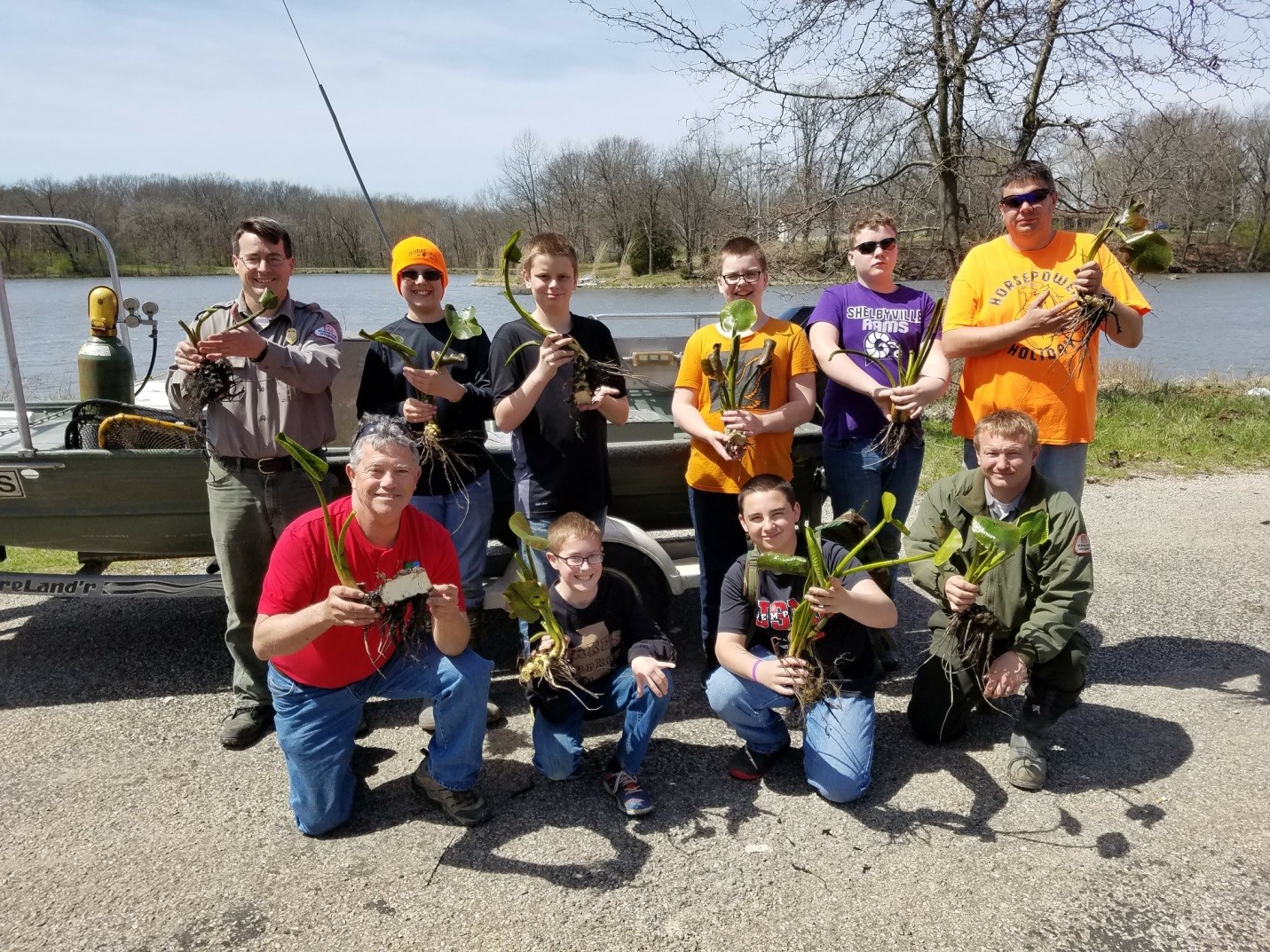
Purpose of the Project:
Lake Shelbyville is the second largest reservoir in Illinois and is an important recreational and economic feature in east-central Illinois. Habitat degradation threatens the viability of the fishery and the associated recreational and economic value. Lake Shelbyville has been impounded for 46+ years. Major habitat impairments include sedimentation due to sediment inputs from the watershed and shoreline erosion largely due to frequent water level fluctuations and loss of woody structure commensurate with the reservoir aging process. Very little dead standing timber remains in coves as most have decayed over the last 40 years. Long-duration floods, on occasion in excess of 12’, have further stranded woody habitat in uplands resulting in additional habitat loss. These floods have made conditions difficult for aquatic vegetation to establish. This lack of habitat and associated erosion and reduced water quality are negatively affecting the quality of the fishery and habitat restoration efforts have not kept up with losses. Standard management practices help maintain the quality of the fishery, but the standard reduction in quality with reservoir age continues with rippling economic effects throughout the community and region.
Purpose of the Project:
Lake Shelbyville is the second largest reservoir in Illinois and is an important recreational and economic feature in east-central Illinois. Habitat degradation threatens the viability of the fishery and the associated recreational and economic value. Lake Shelbyville has been impounded for 46+ years. Major habitat impairments include sedimentation due to sediment inputs from the watershed and shoreline erosion largely due to frequent water level fluctuations and loss of woody structure commensurate with the reservoir aging process. Very little dead standing timber remains in coves as most have decayed over the last 40 years. Long-duration floods, on occasion in excess of 12’, have further stranded woody habitat in uplands resulting in additional habitat loss. These floods have made conditions difficult for aquatic vegetation to establish. This lack of habitat and associated erosion and reduced water quality are negatively affecting the quality of the fishery and habitat restoration efforts have not kept up with losses. Standard management practices help maintain the quality of the fishery, but the standard reduction in quality with reservoir age continues with rippling economic effects throughout the community and region.
Habitat restoration efforts have been ongoing on Shelbyville with habitat efforts being intensified since 2013. Natural woody vegetation has been added in the form of Christmas trees and other locally available cedar and hardwood timber. The U.S. Army Corps of Engineers (USACE) has invested over $2.5 million in shoreline stabilization efforts on the lake’s most erodible shorelines. USACE’s Research and Development Center (ERDC), Lewisville Aquatic Ecosystem Research Facility (LAERF), in conjunction with the Illinois Department of Natural Resources has developed a native aquatic vegetation management plan to help restore littoral habitat. An aquatic plant nursery has been constructed and native plants for transfer to the lake are being cultivated. Frequent floods previously mentioned has made an establishment of significant stands of native vegetation difficult. Project partners are currently focusing on constructing and placing “modified Georgia Cubes” locally known as “Shelbyville Cubes” to replace the woody structure. Reservoir Fisheries Habitat Partnership funding ($30,000) has been used to purchase materials to build and place these structures. NFHP-funding has leveraged over $800,000 in partner funds over the current project timeline: September 2018 through December 2019
Project objectives include:
1) placing long-lasting structural and biological habitat: 2) inhibit shoreline erosion of key areas; 3) inhibit mobilization of sediment and nutrients, and 4) maintain connectivity of coves to the main lake. The benefits expected include increased complexity and diversity of habitat for fish and other wildlife, decreased turbidity, siltation, and nutrient loading for improved water quality. It is also expected to improve deepwater refuge availability during summer stratification to provide increased density of priority game fishes and other desirable organisms for greater quality of experiences for anglers, hunters, ecotourists, and increase local business revenue for increased quality of life for all residents within the influence of the reservoir. Project deliverables include up to 500 Shelbyville cubes (20,000 ft3), up to 250 Georgia cubes (10,000 ft3), 30 artificial logs, 30 artificial stumps, 4,800 ft2 of native aquatic vegetation plantings, doubling the size of the aquatic plant nursery to six 8’-pools and stabilize approximately 5,000 feet of severely eroding shoreline. The success of the project will be gauged primarily by the improved quality of the fishery, fish use of habitat structures, and secondarily by water quality improvements, bank stabilization, and reduced sedimentation. The Illinois Natural History Survey will monitor the success of the program through ongoing graduate student research efforts.
One of the most impressive aspects of this project is the large number of and diversity of project partners led by the U.S. Army Corps of Engineers and the Illinois Department of Natural Resources. Other partners include: The University of Illinois-Illinois Natural History Survey, City of Shelbyville, City of Sullivan, Lake Shelbyville Fish Habitat Alliance, Living Lands & Waters, Lake Shelbyville Volunteer Association, Illinois Muskie Tournament Trail, Central Illinois Crappie Club, Springfield Crappie Club, Lake Shelbyville Muskie Club, Champaign County Bassmasters, Crappie Camp, Central Illinois Crappie Club, Lake Shelbyville Muskie Club, Illini Muskies Alliance, Shawnee Muskie Hunters, Chicagoland Muskie Club, Springfield Crappie Club, Angler’s Choice Tournament Trail. Local business owners have worked within the community to obtain materials at reduced costs and supply volunteer labor to build and place the structures.
Human Interest/Community Benefit:
Local businesses have experienced an economic decline associated with the decline in the quality of the fisheries and decreased angler use. However, reports from the spring of 2018 indicate that fish are using the structures and angler-use has increased.
Project Timeline: September 2018 through December 2019
Economic Calculator results (based on cost estimates from 2013 through the present):
Create 42.6 jobs,
generate $4.70 in total sales,
$2.55 million in value-added creating income of $1.64 million over the 10-year implementation
Project Submission by:
The Reservoir Fish Habitat Partnership
